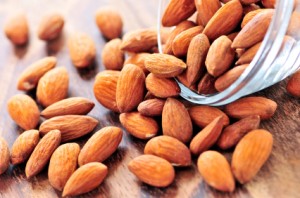How To Make Your Own Nut Milk
It could be that you’re lactose intolerant, or you might just be sick of dairy clogging you up and leaving you bloated. If intolerance is your problem then raw dairy is one great option and should leave your digestive system worry-free, but if – like me – you’re simply not a huge milk lover, then you might just luurve this great nut milk recipe. And why wouldn’t you make it yourself when it’s quite possibly the easiest recipe ever? Not to mention that home-made stuff always tastes better (and you can ensure its quality)!
Don’t forget that nuts are a fantastic source of protein and fat (walnuts even contain Omega 3 essential fatty acids), and can be consumed daily as part of a healthy diet. Keep in mind, however, that they are very nutrient dense, so it’s best to stick with around 60 raw nuts per day, or one glass of nut milk. You can drink nut milk straight, use it instead of milk and water in this fat-blasting smoothie recipe, or substitute it for any form of milk in your cooking and baking. You can even adapt the recipe to make your own healthy spreads.
Super-Simple Nut Milk Recipe
Soak 1 cup of raw nuts (almonds or brazil are my faves, but any nuts are fine) overnight in purified water. Soaking the nuts softens them, and also rids them of harmful phytic acid. The phytates in phytic acid bind to minerals (such as calcium, iron and zinc) in your body, and prevent them from being absorbed. Not good!
Anyway, once the nuts have been soaking for at least 8 hours all you need to do is pour off the water, add 2-4 cups of fresh water (less to make it more like a spread), and blend the nuts for about 3 minutes. You’ll want to stop every half minute or so to give your blender a break. If you’re not going the whole hog and making a smoothie, you may still like to add and blend some dates, a banana or some fresh berries, some stevia powder as a natural sweetener, or some raw cacao powder to boost your antioxidant and magnesium levels.
If the milk seems a little too grainy for your liking then strain it through a tightly woven sieve, cheesecloth, or muslin.
Drink right away, or store in the fridge to be used in cooking later the same day.
Easy!
\


I love making almond milk! Add a little vanilla and you’re good to go.
Should you remove the skins before blending? That was what I was told… is there a big difference? Sounds good. I have no access to raw milk over here on Guam– only dead, highly processed, high heat pasteurized milk. Yuck. I’ve mostly given it up but my kids could def. benefit from the almond milk.
I do still eat plain, whole yogurt (organic when I can find it) but I wish it was, again, raw. Maybe I should buy a goat!
Vanilla is a great idea!
@ Kat – as for skins, you can do it either way. I’m lazy, I just leave them on 🙂 – but you can remove the skins after the almonds have soaked overnight, they come off pretty easy. Oh – goat and sheep’s milk rocks; definitely good for variety.
Hi Kat
Better to keep skins on! As a rule of thumb, eating whole foods is the best way to promote optimal health.
High levels of antioxidants found in almond skins are great for skin health, according to a study in the Journal of Nutrition.
The flavonoids found in almond skins team up with the vitamin E found in their meat to more than double the antioxidant punch either delivers when administered separately. (Journal of Nutrition.)
Twenty potent antioxidant flavonoids were identified in almond skins, some of which are well known as major contributors to the health benefits derived from other foods, such as the catechins found in green tea, and naringenin, which is found in grapefruit.
“Eating almonds with their skins significantly increases both flavonoids and vitamin E in the body. This could have significant health implications, especially as people age.” said Jeffrey Blumberg, Ph.D., senior scientist and director of the Antioxidants Research Laboratory at Tufts University.
As well as providing an array of powerful flavonoids, almonds are also a rich source of vitamin E.
Excellent comment Dave! Thanks for that 🙂